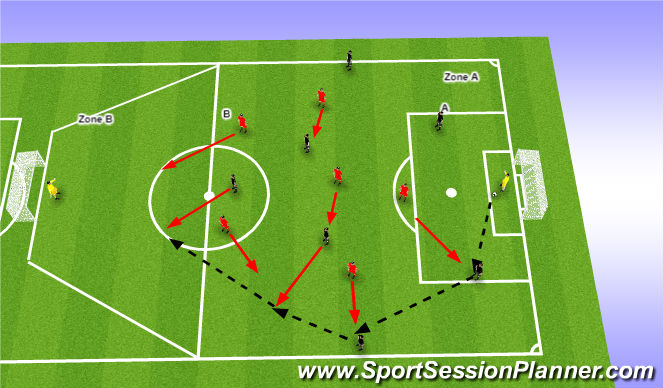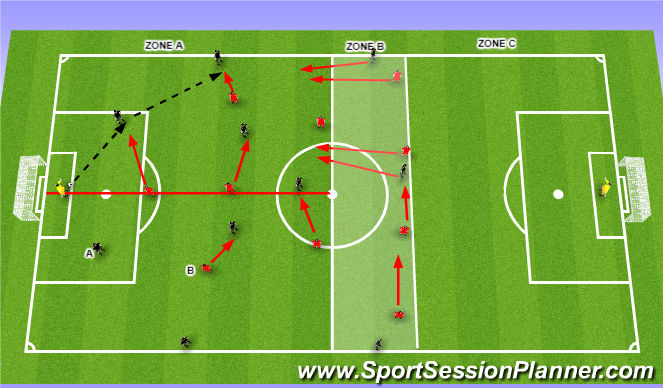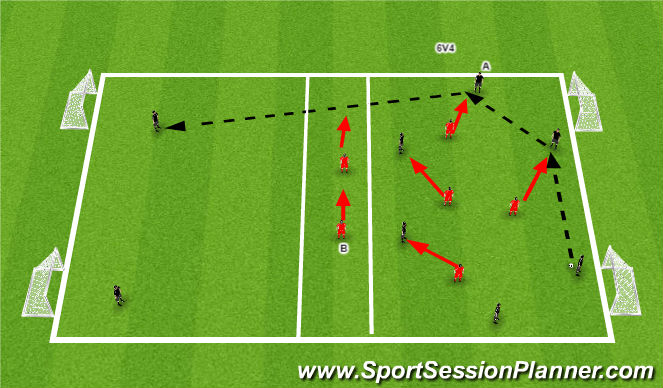Football/Soccer Session (Difficult): High Block Pressing 4231
Profile Summary

| Name: | Nathan Mason |
|---|---|
| City: | Columbia |
| Country: | United States of America |
| Membership: | Adult Member |
| Sport: | Football/Soccer |
Description
Pressing in a compact unit
• Co-ordinating pressure and cover
• Dropping diagonally backwards if opponent
breaks pressure

See the guidance at the top of this page to understand why you are not seeing interactive Football/Soccer images.

7+GK vs 6+GK (25 mins)
Organization:
This practice builds upon Part 1 by applying the concepts in a tactical situation game. The practice sees a group of 15 players split into a group of eight players (seven outfield players and a GK) and a group of seven players (six outfield players and a GK).
Instructions:
• This 7+GK vs 6+GK tactical situation game builds off the previous positional possession game. Team A builds up in a 2-4-1 formation, while Team B presses in a 2-3-1 formation. The exercise begins with the Team A GK in Zone A. The team must connect 2 passes before playing a pass into a teammate in Zone B – designated here by the halfline. Team B aims to score a goal within 6 sec of recovering possession. The halfline also serves as an offside line. Once a pass is played into that zone, it is a 1v1+GK situation for 6 sec. If the ball goes out of bounds, a goal is scored or Team B’s defender recovers possession in Zone B, a new ball will begin with the Team A goalkeeper in Zone A.
Coaching Points/Questions:
OUT OF POSSESSION
COMPACTNESS
• Press together in a compact unit, moving together in a 2-3-1 shape with the central thought of ‘force play wide’. Once the first pass is played towards the sideline, shift together as a unit, stepping to defend the closest mark while being aware of defending passing lines.
SHIFTING
• The forward is responsible for forcing the first pass wide and not allowing the ball to be rotated through the centre-backs. Once the ball is in the side lane, the far-side winger must stay connected to his number 10, denying the possibility of a split pass between players and marking one of the holding midfielders. The two midfielders must shift with the play, denying passing lines into the target players.
BALL ROTATION
• If the opponent is able to rotate the ball through the second CB, the far-side winger will jump to press as the ball is travelling and deny the option to play to the FB – especially if it is a poor pass or touch.
• The central midfielders must be ready to shift and deny passing options. If pressing the second CB is not possible (late to press, ball rotated too fast), the group must drop diagonally to defend the space before initiating a new pressing sequence.
1v1 DEFENDING
• When the opponent is able to successfully receive in Zone B to initiate the 1v1+GK situation, the defender must first contain the attacker with the thought of forcing them wide. Use arms to control the attacker, but do not foul. Use ‘choppy’ steps before blocking any shot to limit the possibility of the attacker shooting through legs.
MANAGING THE OPPOSITION
• Circulate the ball quickly, using as few touches as possible, even though there are no touch restrictions. Maintain the positioning of the two CB, the two FB and the three midfielders. The
midfielders look to prioritise central movements and spaces. Alternate short and long passes, exposing defenders to different situations and making play unpredictable. When possession is lost, apply a fast counter-press to regain the ball as quickly as possible. Once possession is regained, immediately reorganise team positioning.
Regressions/Progressions:

See the guidance at the top of this page to understand why you are not seeing interactive Football/Soccer images.

Conditioned 11v11 (25 mins)
Organization:
This is a large-sided-game in which there are conditions to apply the pressing concepts to the whole team. • The practice sees a group of 22 players split up into two groups of 11 players.
Instructions:
• This conditioned 11v11 progresses from the previous practice by adding in a back four. Team A plays in a 2-4-1-3 formation, while Team B defends in a 4-2-3-1 formation. The exercise begins with Team A’s GK in Zone A, where there is a 7+GK vs 6 situation. After 2 passes in Zone A, Team A looks to pass to a teammate in Zone C. In Zone B, there are three attackers for Team A and four defenders for Team B. Once the ball is in play, both Team A and Team B are allowed to have two players move from Zone B into Zone A. The location of the ball will dictate which players do this. Using the dashed line as a guide, the players on the same side as the ball are free to move into Zone A. In the example here, the ball is on the right side of the pitch, so the players on that side can move into Zone A. If the ball rotates to the other side, they must move back into Zone B to allow the players on the opposite side to move into Zone A. The three midfielders for Team A are allowed to make penetrating runs from Zone A into Zone C to receive a pass – but only one at a time. One midfielder on Team B can drop into Zone B. While the ball is in Zone A, the deeper black line closest to the Team B goal will serve as the offside line. Once play becomes a normal 11v11 or if Team B recovers the ball in Zone A, the normal offside rule is in effect. Once Team A progresses with the ball into Zone C, or Team B recovers the ball in Zone B or Zone C, the game becomes a live, normal 11v11 game. After a goal or a ball out of bounds over the end line, play restarts as pictured here. Play regular throw-ins once Team A progresses into Zone C. When Team B recovers possession in Zone A, they have 8 seconds to score a goal. After a goal or a ball out of bounds, play restarts with the Team A GK..
Coaching Points/Questions:
Same coaching points as previous exercise:
COMPACTNESS
SHIFTING
BALL ROTATION
OFFENSIVE TRANSITION
MANAGING THE OPPOSITION
DEFENSIVE COVERAGE
• When the ball progresses into the side lane and the opposing forwards drop into Zone A, the team must ensure defensive coverage, denying the possibility of an opponent taking advantage of a defensive imbalance. If a defender steps to defend a direct mark, the defensive line must shift to ensure coverage in depth. If a centre-back follows an attacker too far, one of the defensive midfielders can drop into the defensive line to ensure defensive balance.
Regressions/Progressions:








 Play animation
Play animation Play step-by-step
Play step-by-step Repeat (toggle)
Repeat (toggle) Full Screen
Full Screen Pause
Pause Stop
Stop
6+2vs4+2 (20 mins)
Organization:
This practice is a small-scale possession game that is geared towards laying down the pressing concepts. The practice sees a group of 14 players split into a group of 8 players and a group of 6 players.
Instructions:
This 6+2 vs 4+2 positional possession game sees one team – Team A – set up in a 4-2-2 shape against Team B, which positions in a 2-3-1 shape. Team A aims to connect 5 passes in the initial 6v4
scenario before passing the ball towards their two teammates in the opposite half of the playing area. Team B presses in a 3-1 shape in the 6v4 scenario. Two players are restricted to the middle zone and shuffle across, trying to intercept passes from Team A. Team A scores a goal by connecting 5 passes and then transferring the ball – with a pass on the ground – to the opposite side. Team B scores by intercepting the ball and scoring in one of the two small goals they are facing within 5 seconds. If Team A successfully transfers the ball to the other side, two players stay in the initial zone, while the other four players sprint to the opposite side, quickly regaining the offensive shape. Team B sprints across, quickly organising the two players in the central restricted zone and 3-1 defensive shape in the possession zone. Once on the opposite side, the sequence repeats itself. If a goal is scored by Team B or the ball goes out of bounds, a new ball will be played in on the side it went
out on for Team A to restart.
Coaching Points/Questions:
OUT OF POSSESSION
COMPACTNESS
• Press together in a compact unit, moving together in a 3-1 shape with the central thought of ‘force play wide’. Once the first pass is played towards the sideline, shift together as a unit, stepping to defend the closest mark while being aware of defending passing lines.
SHIFTING
• The forward is responsible for forcing the first pass wide and not allowing the ball to be rotated through the centre-backs. Once the ball is in the side lane, the far-side winger must stay connected to his number 10, denying the possibility of a split pass between players and marking one of the holding midfielders. The two midfielders must shift with the play, stepping to defend the opposing midfielder if they receive behind the winger while the other marks the opposing 10.
BALL ROTATION
• If the opponent is able to rotate the ball through the second centre-back, the far-side winger will jump to press as the ball is travelling and deny the option to play to the full-back – especially if it is a poor pass or touch. The central midfielders must be ready to shift and deny passing options. If pressing the second centre-back is not possible, the group must drop diagonally to defend the space before
initiating a new pressing sequence.
REORGANISE DEFENSIVE SHAPE
• If the opponent is able to successfully transfer the ball to the opposite side, the out-of-possession team must initiate an immediate reaction to press the ball-carrier.The two new players must survey and communicate to the group of four and give clear information (force right, force left, man right, man left etc) in order to quickly establish the collective pressing.
OFFENSIVE TRANSITION
• When possession is recovered, quickly secure it with the first pass and look to switch play towards the opposite side to score a goal.
MANAGING THE OPPOSITION
• Circulate the ball quickly, using as few touches as possible, even though there are no touch restrictions. Maintain positioning of the two centre-backs, the two full-backs and the two midfielders. The midfielders look to prioritise central movements and spaces. When possession is lost, apply a fast counter-press to regain the ball as quickly as possible. Once possession is regained, immediately reorganise team positioning.
Regressions/Progressions: